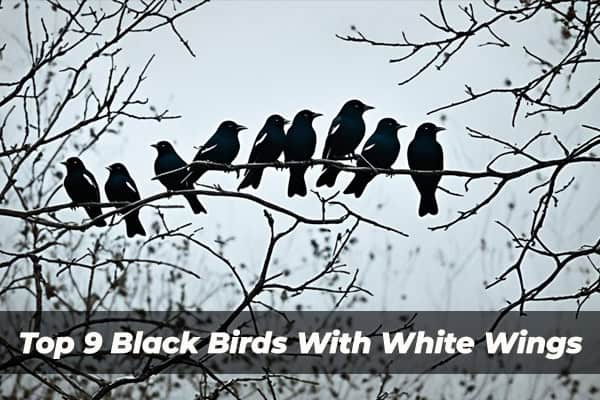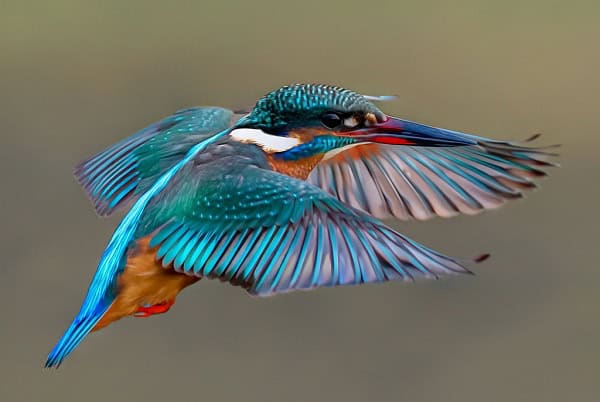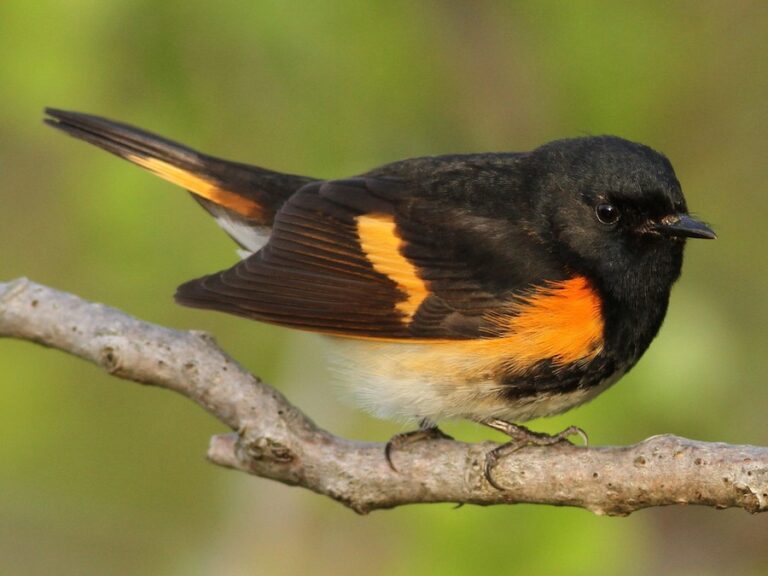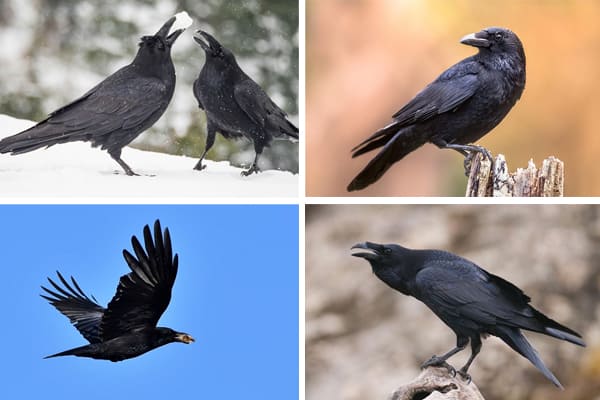Top 9 Black Birds With White Wings (With Pictures)
Have you spotted black birds with white wings? They’re not just tales from Grayson County, Texas. In my research, I discovered 10 captivating species, each with unique black and white patterns. Their beauty is more than feather-deep; it’s in their diverse habitats and behaviors. Join me as we unveil these avian wonders, from their striking appearances to their remarkable lifestyles. Let’s dive into the world of these winged marvels together.
A pigment called melanin colors the top sides of bird feathers black. The area around this pigment is lighter, creating beautiful contrasts. Let’s discover the wide range of black birds with white wings. From the Black-billed Magpie (Pica hudsonia) to the famous Atlantic Puffin (Fratercula arctica).
Here we’ll learn about 9 Black Birds with White Wings!!
1. Black-billed Magpie – Pica hudsonia
The Black-billed Magpie is a large, striking bird. It has a dark body, but a white patch on its belly. Its tail is notably long. Look for a blue-green shine on its wings and tail when the sun hits them.
Appearance and Distinctive Features
These birds are big, bigger than jays but smaller than ravens. They stand out because of their long, shaped tails. They like to hang out in big groups and are curious by nature.

Distribution and Habitat
Black-billed Magpies fill towns and open areas in the West of America and Canada. From the center of the U.S. up to Alaska, you can spot them. They love open places like meadows and fields but also don’t mind cities. You’ll often find them close to water and trees, places where they can hide from danger.
Diet and Feeding Habits
They eat almost anything. Their diet includes fruits, nuts, seeds, bugs, and even meat. They’re quite talkative, making all kinds of sounds. When they fly, their movements are fascinating. Their tails help them turn sharply, almost like their wings alone wouldn’t be enough.
2. Black Skimmer – Rynchops niger
The Black Skimmer is an impressive seabird. It has dark upperparts and white underparts. Its wings have white edges, and its tail is white with a black line. The bird’s beak is large, black, and has an orange-red base. The bottom part is used to catch fish and crustaceans on the water’s surface.

Unique Beak Structure and Feeding Behavior
The Black Skimmer flies low over water in a unique way. It skims the surface with its beak while flying. They are bigger than Laughing Gulls but smaller than Royal Terns. You can tell younger skimmers apart because they have more white and brown markings.
Geographic Range and Migration Patterns
These birds live in the southern United States, the Caribbean, and South America. Some travel south in winter, but many stay year-round. They like gathering on beaches and other sandy places. There are small differences in appearance between skimmers from North America and skimmers from South America.
Coastal and Wetland Habitats
Black Skimmers are often seen near the coast. They live on sandy beaches and in salt marshes. They also visit big lakes far from the sea. Skimmers look for food over water, catching small fish. Their wings are about 48 inches across.
3. Black Phoebe – Sayornis nigricans
The black phoebe is a small, black bird with a white belly. It lives in the western U.S., Mexico, Central America, and countries in northern South America. Depending on where they are, their look changes. In North America, they have black bodies with white wings. But in South America, they’re mostly black with white wing edges and bellies.
In their range, near water or people, you often see these birds. They love places like riverbanks, coasts, lakes, and streams. Some black phoebes fly south during winter, but most stay where they are.

These birds eat mainly insects but will also catch small fish. Sometimes they even feed fish to their babies. Although rare, black phoebes have been spotted in Florida too.
| Black Phoebe Characteristics | Value |
|---|---|
| Length | 16 cm (6.3 in) |
| Weight | 15 to 22 g (0.5 to 0.8 oz) |
| Recognized Subspecies | Six |
| Subspecies in the nigricans group (black phoebe) | Four |
| Subspecies in the latirostris group (white-winged phoebe) | Two |
| Distribution | Breeds in the west and southwest United States, Mexico, Central America, and parts of South America |
| Behavioral Characteristic | Recognizable by a characteristic “tail-wagging” motion |
| Tyrant Flycatcher Family Species | Over 400 |
| Genus | Sayornis |
| Year of Latin Species Name | 1827 (by William John Swainson) |
| Conservation Status | Least Concern (IUCN 3.1) |
House Finches once put 5 eggs into a black phoebe nest with 6 phoebe eggs. Both kinds of birds then left the nest. The oldest known black phoebe was over 8 years old. This was in California back in 1981.
4. Black-necked Stilt – Himantopus mexicanus
The black-necked stilt is a stunning shore birds. It stands out with its long, thin pink legs, black beak, and unique black and white wings. Versions of this bird in Hawaii and South America have their special looks.
Distinctive Long Pink Legs and Geographic Variation
This bird has black on the top parts, including the hind neck and cap. Its white parts stand out on the tail, forehead, and around the eyes. Females are browner than the shiny black males. A Hawaiian type shows more black on the forehead and cheeks. The South American version, known as the White-backed Stilt, has a white collar on its upper back.
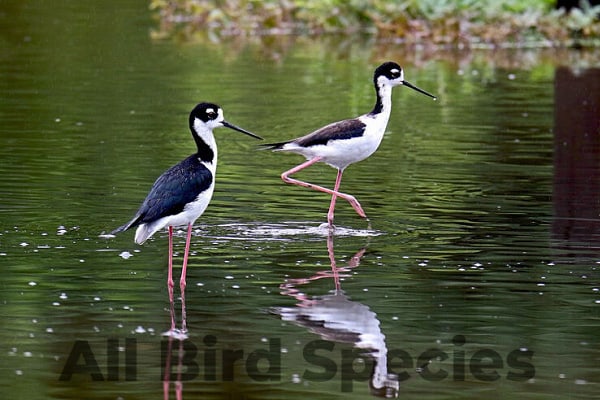
Wetland Habitats and Migration
The black-necked stilt is found from the western and southern U.S. to southern South America. Some stay in the same area all year, but those further north migrate to the south for winter, sometimes as far as southern Mexico. It loves living in wetland places like shallow ponds, mangroves, and human-made flood zones.
Diet and Prey
This bird is great at finding food. It mostly eats invertebrates like crustaceans, arthropods, and mollusks when near mud and lakes. Sometimes, it eats small fish, tadpoles, and plant seeds too.
5. Razorbill – Alca torda
The Razorbill seabird is stunning, with a mix of black and white feathers. In the breeding season, it has a black head and white belly. There are white lines by its eye and on its strong, black beak. In the non-breeding season, its throat, cheeks, and face sides turn white.
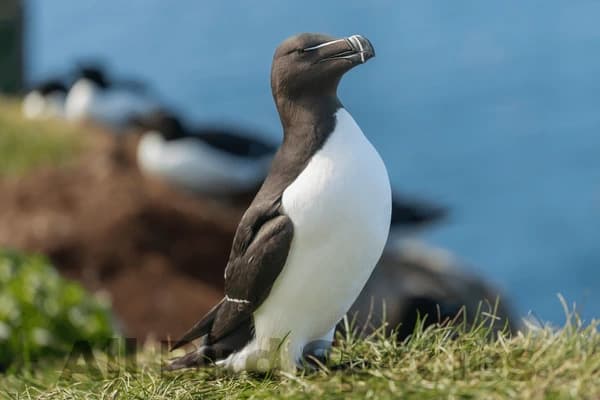
Breeding and Non-Breeding Plumage
In the breeding season, Razorbill looks bold with its black-and-white contrast. But, in the off-season, it changes. Its face and throat turn white, making its color more even.
North Atlantic Distribution and Habitat
Razorbills live in the North Atlantic, ranging from North America’s northeast to Europe’s west. They come near land or on it during the summer for breeding. Then, they move south or farther at sea for winter. These sea black birds with white wings choose rocky sites near the water for summer homes. But, in winter, they prefer the wide ocean.
Fish and Crustacean Diet
Razorbills mainly eat small fish. But, they also enjoy tiny crustaceans and bristle worms, mostly in winter. They are amazing at diving, going down to 120 meters for food.
6. Yellow-billed Magpie – Pica nuttalli
The Yellow-billed Magpie stands out with its black-and-white body and yellow beak. It’s mostly black but has white parts too. These parts are on the flanks, belly, wings, and back. They have distinctive blue-green colors on their long tail and wings. This bird is only found in California in the United States.
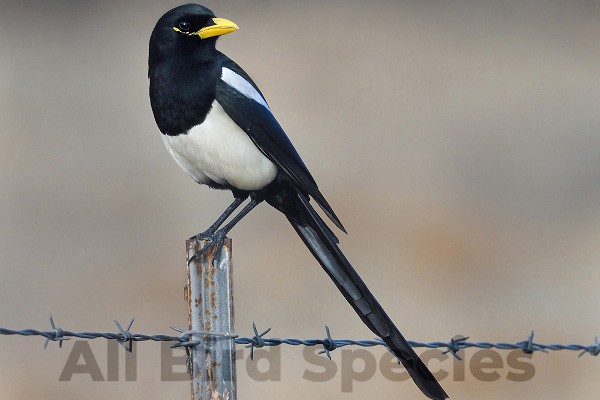
Endemic to California
Endemic means it’s found only in one place. The Yellow-billed Magpie is found in California. It lives in the Central Valley, the southern Coast Ranges, and the Sierra Nevada foothills. They like living in areas with oak trees the most.
Open Woodland and Grassland Habitats
Their favorite places are open oak woodlands, savannas, and fields. You can see these black birds with wings in grasslands, pastures, and orchards too. In the Central Valley, California, they are often heard and seen.
Varied Diet and Foraging Habits
Yellow-billed Magpies eat a variety of things. They eat grains, acorns, and small critters. They also eat fruit, insects, and even dead animals. They often eat in groups, looking for food on the ground. This happens both when they’re making nests and when they’re not.
7. Spotted Towhee – Pipilo maculatus
The Spotted Towhee is an eye-catching bird. It’s mostly black with a white belly and orange-brown sides. Males have a deep black upper side. Their wings and back have white spots. In some areas, they might look more green. Females are usually grayer and less colorful.
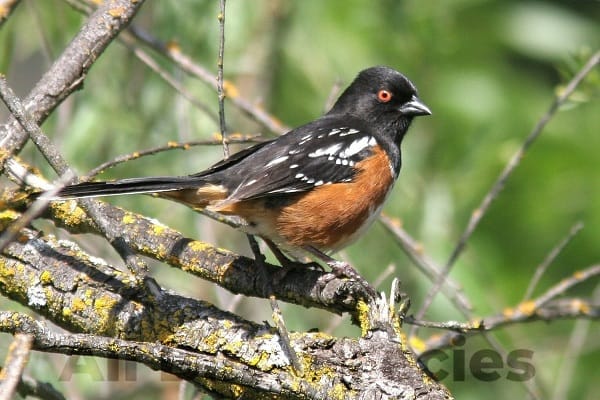
Appearance and Geographic Variation
These birds look different depending on where they live. Their range goes from Canada down to Guatemala. Males have vibrant black, white, and orange-brown colors. Females seem duller. The young birds are streaked with brown. These colors help them blend in with their habitats.
Shrubland and Forest Edge Habitats
These black birds with white wings live in many places. They like open areas with a lot of plants and near the edge of forests. You can often see them on the ground under thick bushes. They look for insects, spiders, and millipedes to eat.
Seasonal Diet Changes
In summer, these birds mostly eat bugs and similar critters. When it gets colder, they eat berries, acorns, and seeds. They even eat some farm crops. This change in diet helps them survive the different times of the year.
Resident and Migratory Populations
Most Spotted Towhees stay in their area all year. But, those in the north sometimes go south for winter. A very old male bird was found in California. It was at least 11 years old. This shows these birds can live a long time.
8. Atlantic Puffin – Fratercula arctica
The Atlantic Puffin is a charming, small seabird. It has a mostly black and white body. Its face is grayish-white with a colorful, large beak. This bird also sports a black collar and eye patches. These patches form a thin line behind its eyes. During non-breeding times, the Puffin’s plumage looks duller. However, they still have their black collar and eye marks. Their faces get darker, and their beaks are not as colorful.
Distinctive Beak and Plumage Changes
In different seasons, the Atlantic Puffin’s look changes a lot. In the breeding season, their beak shows bright colors and unique patterns. Their features become more defined. Yet, as the non-breeding season arrives, their beak gets smaller. They look more subdued with a grayer face.
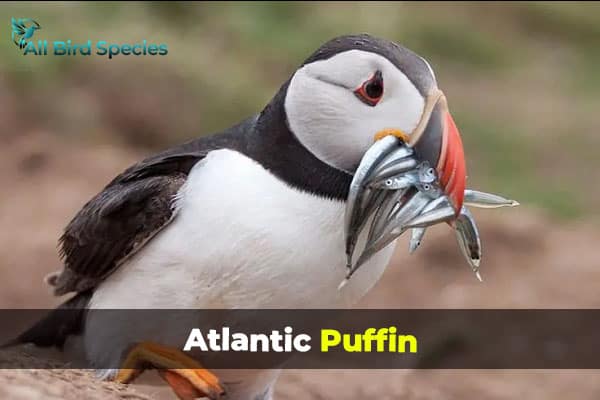
North Atlantic Breeding and Wintering Ranges
Atlantic Puffins live in the North Atlantic Ocean. They are found from the northeastern U.S. and Canada to Europe and North Africa. These seabirds nest on rocky islands and cliffs during the summer. They then move to the open ocean for the winter.
Fish, Squid, and Crustacean Diet
The Atlantic Puffin eats mainly small fish. It also enjoys squid and crustaceans. They are amazing divers, which helps them catch food in the sea.
9. Eastern Towhee – Pipilo erythrophthalmus
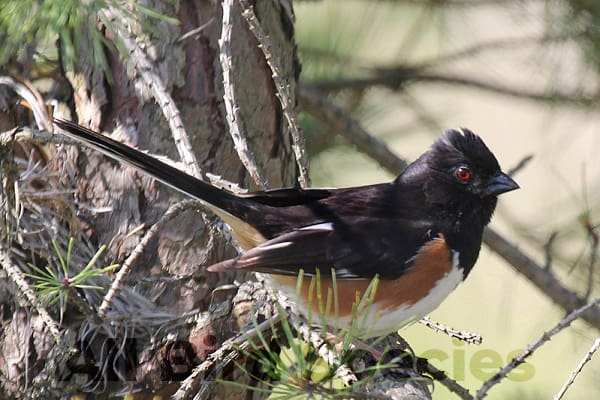
The Eastern Towhee is from the eastern United States and southeastern Canada. It’s a striking songbird. Males and females look different. Males have a black head and throat, but the females have a rich brown color there. Males have red eyes in the north, but those in the south have white eyes.
Both males and females love places like scrublands and forests. They also like overgrown fields. These spots have a lot of hidden places, perfect for finding food. This makes it easier for Eastern Towhees to live.

